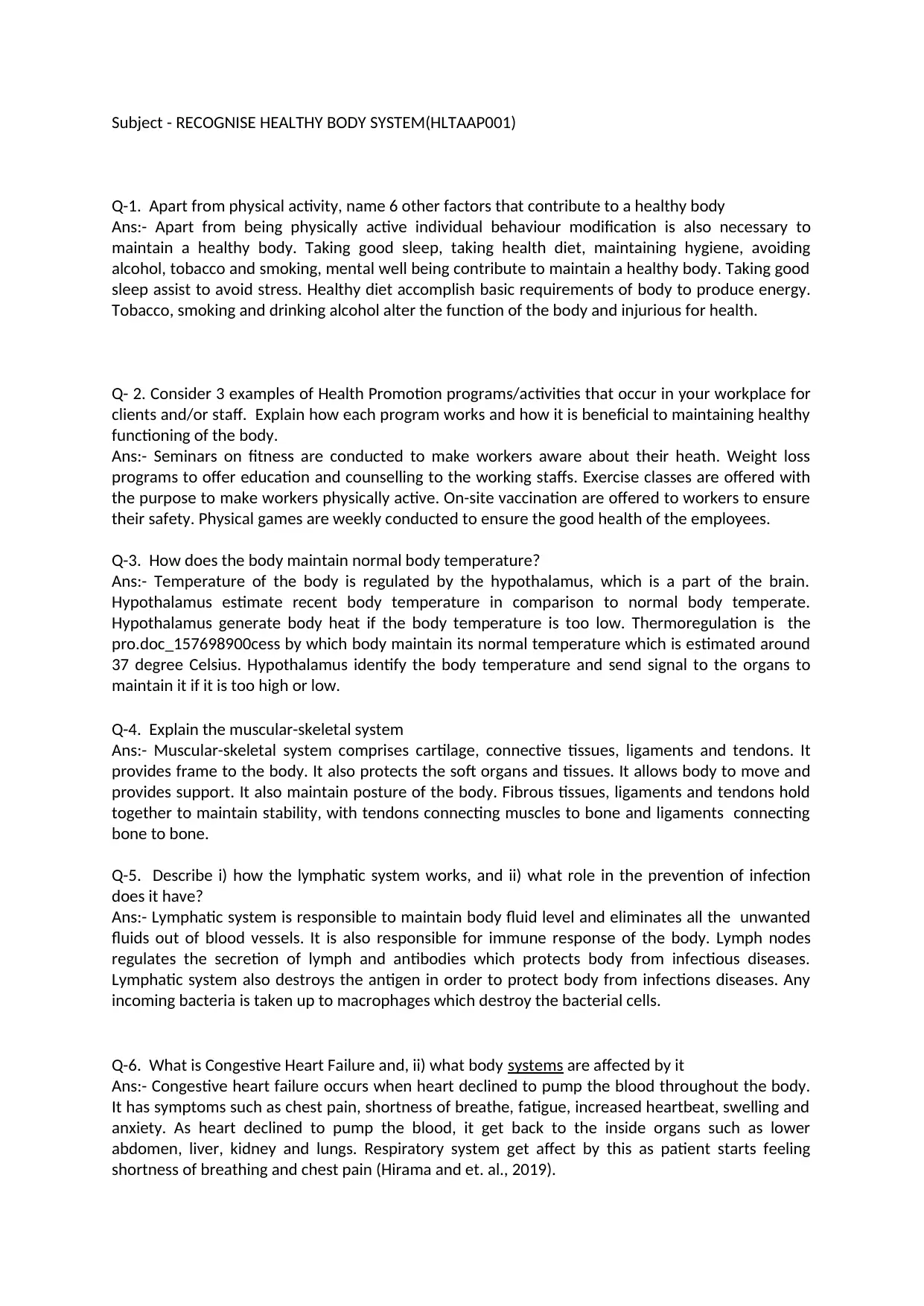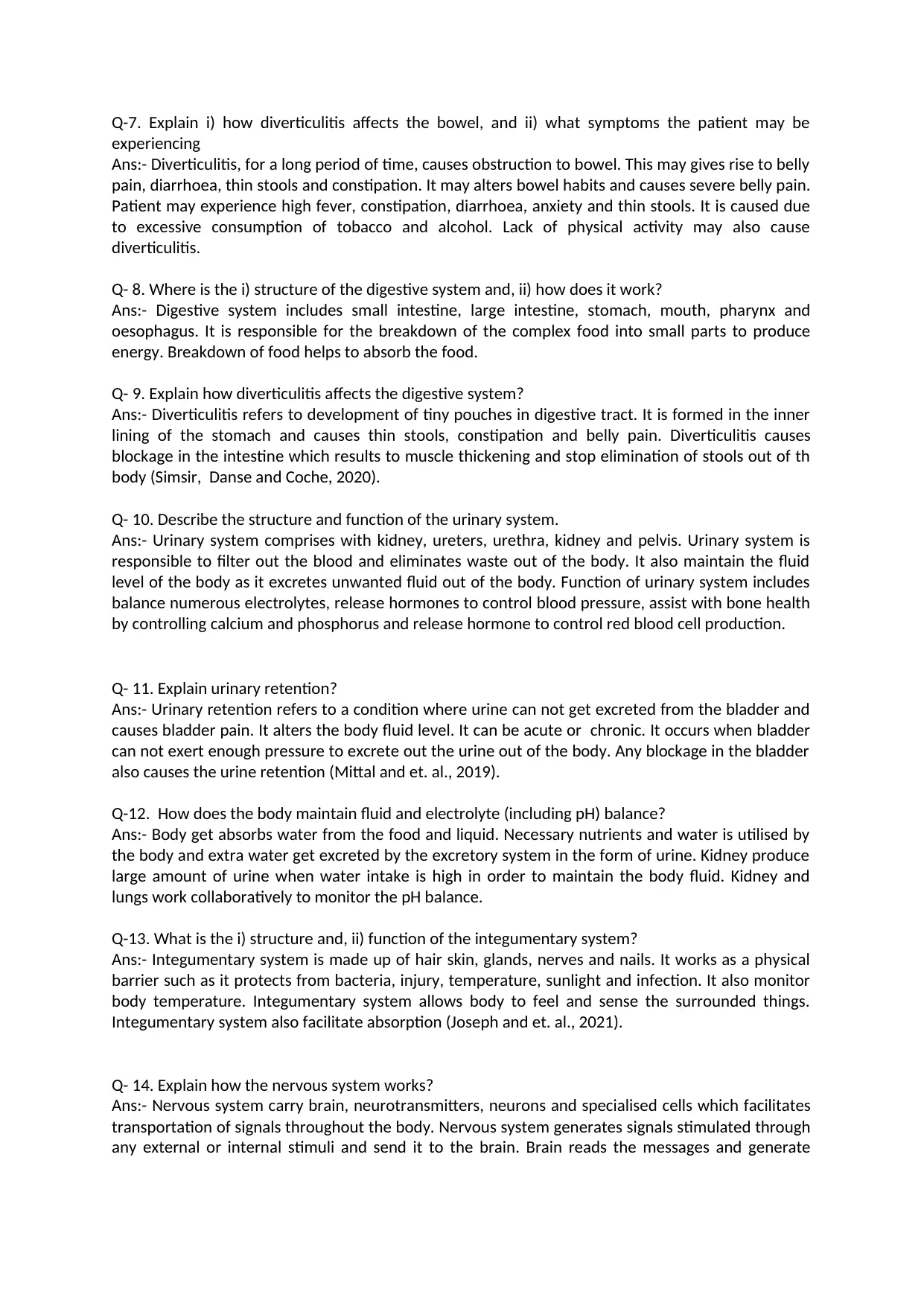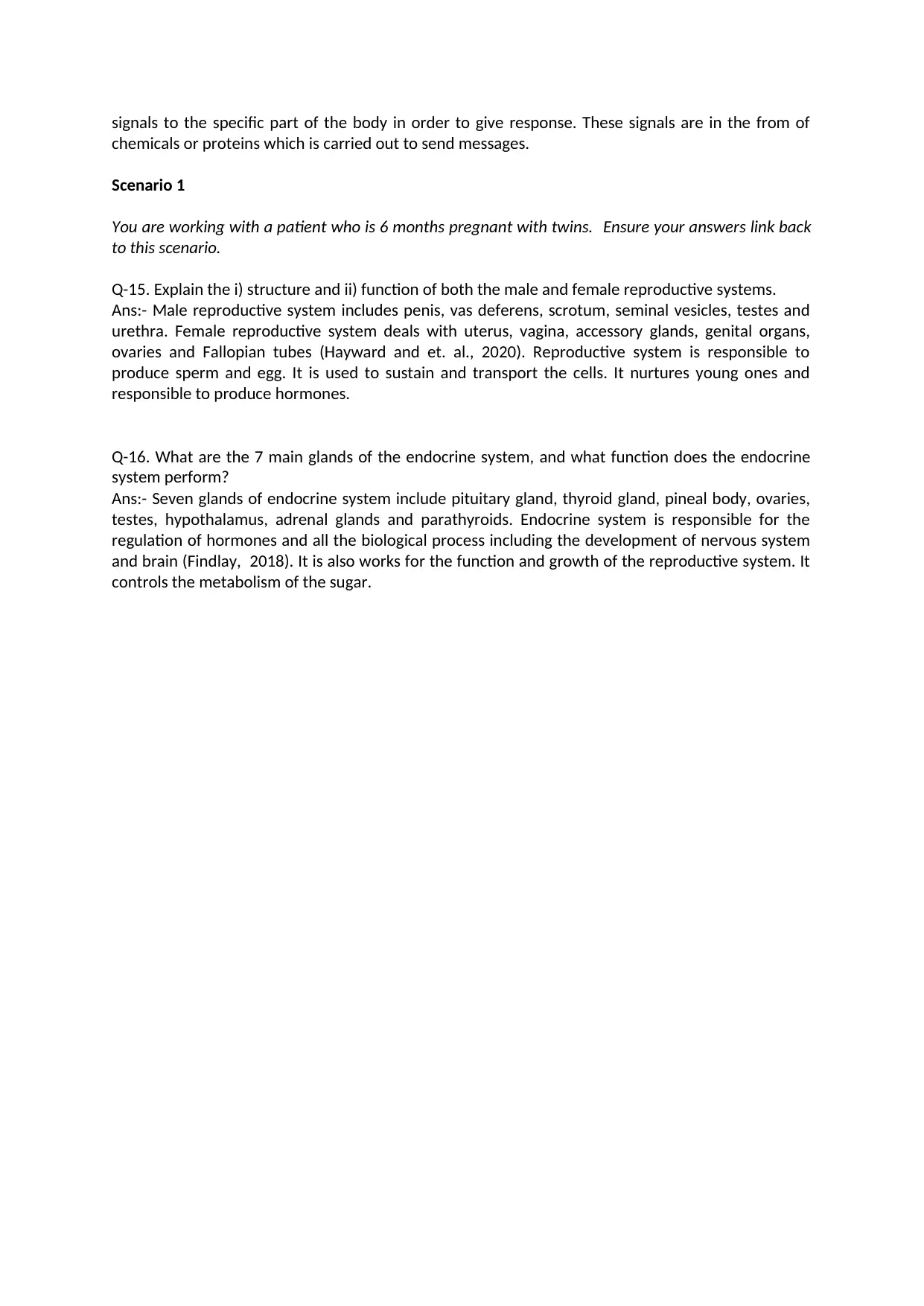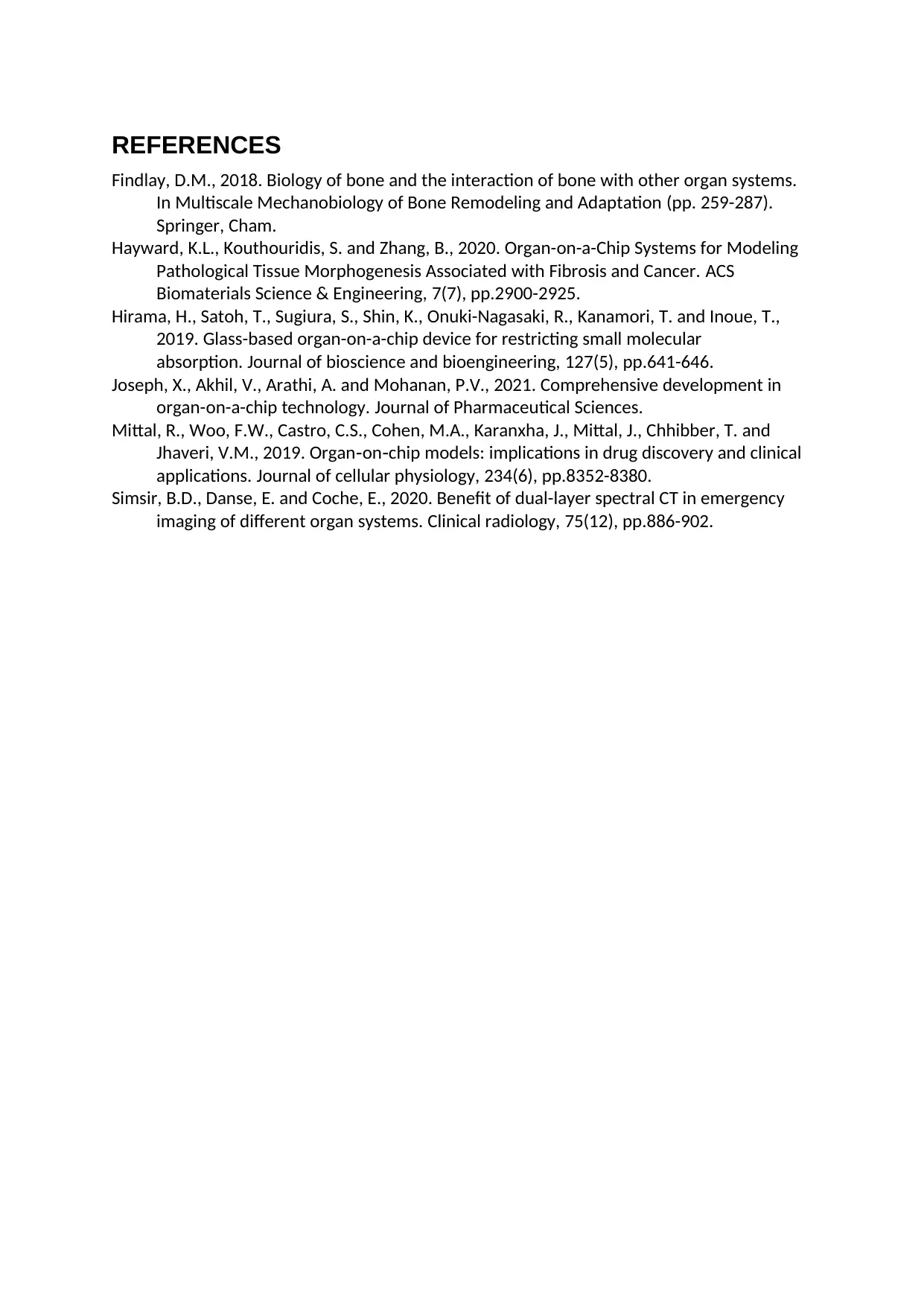Assignment on Recognising Healthy Body Systems (HLTAAP001)
VerifiedAdded on 2023/06/07
|4
|1772
|413
Homework Assignment
AI Summary
This assignment solution addresses key aspects of human health and body systems within the HLTAAP001 curriculum. It begins by identifying factors contributing to a healthy body, and then explores health promotion programs in the workplace, including fitness seminars, weight loss initiatives, exercise classes, and on-site vaccinations. The assignment delves into the body's temperature regulation, the muscular-skeletal system, the lymphatic system and its role in preventing infection, and the nature of congestive heart failure and its effects on the body. It also examines diverticulitis' impact on the bowel and digestive system, including symptoms and structure of the digestive system. The urinary system's structure and function, urinary retention, and fluid/electrolyte balance are also discussed. The integumentary and nervous systems are then covered. The assignment concludes with an examination of the male and female reproductive systems, including the endocrine system and its seven main glands, and links the information to a scenario involving a pregnant patient with twins. The solution provides detailed explanations and uses references to support the answers.

Subject - RECOGNISE HEALTHY BODY SYSTEM(HLTAAP001)
Q-1. Apart from physical activity, name 6 other factors that contribute to a healthy body
Ans:- Apart from being physically active individual behaviour modification is also necessary to
maintain a healthy body. Taking good sleep, taking health diet, maintaining hygiene, avoiding
alcohol, tobacco and smoking, mental well being contribute to maintain a healthy body. Taking good
sleep assist to avoid stress. Healthy diet accomplish basic requirements of body to produce energy.
Tobacco, smoking and drinking alcohol alter the function of the body and injurious for health.
Q- 2. Consider 3 examples of Health Promotion programs/activities that occur in your workplace for
clients and/or staff. Explain how each program works and how it is beneficial to maintaining healthy
functioning of the body.
Ans:- Seminars on fitness are conducted to make workers aware about their heath. Weight loss
programs to offer education and counselling to the working staffs. Exercise classes are offered with
the purpose to make workers physically active. On-site vaccination are offered to workers to ensure
their safety. Physical games are weekly conducted to ensure the good health of the employees.
Q-3. How does the body maintain normal body temperature?
Ans:- Temperature of the body is regulated by the hypothalamus, which is a part of the brain.
Hypothalamus estimate recent body temperature in comparison to normal body temperate.
Hypothalamus generate body heat if the body temperature is too low. Thermoregulation is the
pro.doc_157698900cess by which body maintain its normal temperature which is estimated around
37 degree Celsius. Hypothalamus identify the body temperature and send signal to the organs to
maintain it if it is too high or low.
Q-4. Explain the muscular-skeletal system
Ans:- Muscular-skeletal system comprises cartilage, connective tissues, ligaments and tendons. It
provides frame to the body. It also protects the soft organs and tissues. It allows body to move and
provides support. It also maintain posture of the body. Fibrous tissues, ligaments and tendons hold
together to maintain stability, with tendons connecting muscles to bone and ligaments connecting
bone to bone.
Q-5. Describe i) how the lymphatic system works, and ii) what role in the prevention of infection
does it have?
Ans:- Lymphatic system is responsible to maintain body fluid level and eliminates all the unwanted
fluids out of blood vessels. It is also responsible for immune response of the body. Lymph nodes
regulates the secretion of lymph and antibodies which protects body from infectious diseases.
Lymphatic system also destroys the antigen in order to protect body from infections diseases. Any
incoming bacteria is taken up to macrophages which destroy the bacterial cells.
Q-6. What is Congestive Heart Failure and, ii) what body systems are affected by it
Ans:- Congestive heart failure occurs when heart declined to pump the blood throughout the body.
It has symptoms such as chest pain, shortness of breathe, fatigue, increased heartbeat, swelling and
anxiety. As heart declined to pump the blood, it get back to the inside organs such as lower
abdomen, liver, kidney and lungs. Respiratory system get affect by this as patient starts feeling
shortness of breathing and chest pain (Hirama and et. al., 2019).
Q-1. Apart from physical activity, name 6 other factors that contribute to a healthy body
Ans:- Apart from being physically active individual behaviour modification is also necessary to
maintain a healthy body. Taking good sleep, taking health diet, maintaining hygiene, avoiding
alcohol, tobacco and smoking, mental well being contribute to maintain a healthy body. Taking good
sleep assist to avoid stress. Healthy diet accomplish basic requirements of body to produce energy.
Tobacco, smoking and drinking alcohol alter the function of the body and injurious for health.
Q- 2. Consider 3 examples of Health Promotion programs/activities that occur in your workplace for
clients and/or staff. Explain how each program works and how it is beneficial to maintaining healthy
functioning of the body.
Ans:- Seminars on fitness are conducted to make workers aware about their heath. Weight loss
programs to offer education and counselling to the working staffs. Exercise classes are offered with
the purpose to make workers physically active. On-site vaccination are offered to workers to ensure
their safety. Physical games are weekly conducted to ensure the good health of the employees.
Q-3. How does the body maintain normal body temperature?
Ans:- Temperature of the body is regulated by the hypothalamus, which is a part of the brain.
Hypothalamus estimate recent body temperature in comparison to normal body temperate.
Hypothalamus generate body heat if the body temperature is too low. Thermoregulation is the
pro.doc_157698900cess by which body maintain its normal temperature which is estimated around
37 degree Celsius. Hypothalamus identify the body temperature and send signal to the organs to
maintain it if it is too high or low.
Q-4. Explain the muscular-skeletal system
Ans:- Muscular-skeletal system comprises cartilage, connective tissues, ligaments and tendons. It
provides frame to the body. It also protects the soft organs and tissues. It allows body to move and
provides support. It also maintain posture of the body. Fibrous tissues, ligaments and tendons hold
together to maintain stability, with tendons connecting muscles to bone and ligaments connecting
bone to bone.
Q-5. Describe i) how the lymphatic system works, and ii) what role in the prevention of infection
does it have?
Ans:- Lymphatic system is responsible to maintain body fluid level and eliminates all the unwanted
fluids out of blood vessels. It is also responsible for immune response of the body. Lymph nodes
regulates the secretion of lymph and antibodies which protects body from infectious diseases.
Lymphatic system also destroys the antigen in order to protect body from infections diseases. Any
incoming bacteria is taken up to macrophages which destroy the bacterial cells.
Q-6. What is Congestive Heart Failure and, ii) what body systems are affected by it
Ans:- Congestive heart failure occurs when heart declined to pump the blood throughout the body.
It has symptoms such as chest pain, shortness of breathe, fatigue, increased heartbeat, swelling and
anxiety. As heart declined to pump the blood, it get back to the inside organs such as lower
abdomen, liver, kidney and lungs. Respiratory system get affect by this as patient starts feeling
shortness of breathing and chest pain (Hirama and et. al., 2019).
Paraphrase This Document
Need a fresh take? Get an instant paraphrase of this document with our AI Paraphraser

Q-7. Explain i) how diverticulitis affects the bowel, and ii) what symptoms the patient may be
experiencing
Ans:- Diverticulitis, for a long period of time, causes obstruction to bowel. This may gives rise to belly
pain, diarrhoea, thin stools and constipation. It may alters bowel habits and causes severe belly pain.
Patient may experience high fever, constipation, diarrhoea, anxiety and thin stools. It is caused due
to excessive consumption of tobacco and alcohol. Lack of physical activity may also cause
diverticulitis.
Q- 8. Where is the i) structure of the digestive system and, ii) how does it work?
Ans:- Digestive system includes small intestine, large intestine, stomach, mouth, pharynx and
oesophagus. It is responsible for the breakdown of the complex food into small parts to produce
energy. Breakdown of food helps to absorb the food.
Q- 9. Explain how diverticulitis affects the digestive system?
Ans:- Diverticulitis refers to development of tiny pouches in digestive tract. It is formed in the inner
lining of the stomach and causes thin stools, constipation and belly pain. Diverticulitis causes
blockage in the intestine which results to muscle thickening and stop elimination of stools out of th
body (Simsir, Danse and Coche, 2020).
Q- 10. Describe the structure and function of the urinary system.
Ans:- Urinary system comprises with kidney, ureters, urethra, kidney and pelvis. Urinary system is
responsible to filter out the blood and eliminates waste out of the body. It also maintain the fluid
level of the body as it excretes unwanted fluid out of the body. Function of urinary system includes
balance numerous electrolytes, release hormones to control blood pressure, assist with bone health
by controlling calcium and phosphorus and release hormone to control red blood cell production.
Q- 11. Explain urinary retention?
Ans:- Urinary retention refers to a condition where urine can not get excreted from the bladder and
causes bladder pain. It alters the body fluid level. It can be acute or chronic. It occurs when bladder
can not exert enough pressure to excrete out the urine out of the body. Any blockage in the bladder
also causes the urine retention (Mittal and et. al., 2019).
Q-12. How does the body maintain fluid and electrolyte (including pH) balance?
Ans:- Body get absorbs water from the food and liquid. Necessary nutrients and water is utilised by
the body and extra water get excreted by the excretory system in the form of urine. Kidney produce
large amount of urine when water intake is high in order to maintain the body fluid. Kidney and
lungs work collaboratively to monitor the pH balance.
Q-13. What is the i) structure and, ii) function of the integumentary system?
Ans:- Integumentary system is made up of hair skin, glands, nerves and nails. It works as a physical
barrier such as it protects from bacteria, injury, temperature, sunlight and infection. It also monitor
body temperature. Integumentary system allows body to feel and sense the surrounded things.
Integumentary system also facilitate absorption (Joseph and et. al., 2021).
Q- 14. Explain how the nervous system works?
Ans:- Nervous system carry brain, neurotransmitters, neurons and specialised cells which facilitates
transportation of signals throughout the body. Nervous system generates signals stimulated through
any external or internal stimuli and send it to the brain. Brain reads the messages and generate
experiencing
Ans:- Diverticulitis, for a long period of time, causes obstruction to bowel. This may gives rise to belly
pain, diarrhoea, thin stools and constipation. It may alters bowel habits and causes severe belly pain.
Patient may experience high fever, constipation, diarrhoea, anxiety and thin stools. It is caused due
to excessive consumption of tobacco and alcohol. Lack of physical activity may also cause
diverticulitis.
Q- 8. Where is the i) structure of the digestive system and, ii) how does it work?
Ans:- Digestive system includes small intestine, large intestine, stomach, mouth, pharynx and
oesophagus. It is responsible for the breakdown of the complex food into small parts to produce
energy. Breakdown of food helps to absorb the food.
Q- 9. Explain how diverticulitis affects the digestive system?
Ans:- Diverticulitis refers to development of tiny pouches in digestive tract. It is formed in the inner
lining of the stomach and causes thin stools, constipation and belly pain. Diverticulitis causes
blockage in the intestine which results to muscle thickening and stop elimination of stools out of th
body (Simsir, Danse and Coche, 2020).
Q- 10. Describe the structure and function of the urinary system.
Ans:- Urinary system comprises with kidney, ureters, urethra, kidney and pelvis. Urinary system is
responsible to filter out the blood and eliminates waste out of the body. It also maintain the fluid
level of the body as it excretes unwanted fluid out of the body. Function of urinary system includes
balance numerous electrolytes, release hormones to control blood pressure, assist with bone health
by controlling calcium and phosphorus and release hormone to control red blood cell production.
Q- 11. Explain urinary retention?
Ans:- Urinary retention refers to a condition where urine can not get excreted from the bladder and
causes bladder pain. It alters the body fluid level. It can be acute or chronic. It occurs when bladder
can not exert enough pressure to excrete out the urine out of the body. Any blockage in the bladder
also causes the urine retention (Mittal and et. al., 2019).
Q-12. How does the body maintain fluid and electrolyte (including pH) balance?
Ans:- Body get absorbs water from the food and liquid. Necessary nutrients and water is utilised by
the body and extra water get excreted by the excretory system in the form of urine. Kidney produce
large amount of urine when water intake is high in order to maintain the body fluid. Kidney and
lungs work collaboratively to monitor the pH balance.
Q-13. What is the i) structure and, ii) function of the integumentary system?
Ans:- Integumentary system is made up of hair skin, glands, nerves and nails. It works as a physical
barrier such as it protects from bacteria, injury, temperature, sunlight and infection. It also monitor
body temperature. Integumentary system allows body to feel and sense the surrounded things.
Integumentary system also facilitate absorption (Joseph and et. al., 2021).
Q- 14. Explain how the nervous system works?
Ans:- Nervous system carry brain, neurotransmitters, neurons and specialised cells which facilitates
transportation of signals throughout the body. Nervous system generates signals stimulated through
any external or internal stimuli and send it to the brain. Brain reads the messages and generate

signals to the specific part of the body in order to give response. These signals are in the from of
chemicals or proteins which is carried out to send messages.
Scenario 1
You are working with a patient who is 6 months pregnant with twins. Ensure your answers link back
to this scenario.
Q-15. Explain the i) structure and ii) function of both the male and female reproductive systems.
Ans:- Male reproductive system includes penis, vas deferens, scrotum, seminal vesicles, testes and
urethra. Female reproductive system deals with uterus, vagina, accessory glands, genital organs,
ovaries and Fallopian tubes (Hayward and et. al., 2020). Reproductive system is responsible to
produce sperm and egg. It is used to sustain and transport the cells. It nurtures young ones and
responsible to produce hormones.
Q-16. What are the 7 main glands of the endocrine system, and what function does the endocrine
system perform?
Ans:- Seven glands of endocrine system include pituitary gland, thyroid gland, pineal body, ovaries,
testes, hypothalamus, adrenal glands and parathyroids. Endocrine system is responsible for the
regulation of hormones and all the biological process including the development of nervous system
and brain (Findlay, 2018). It is also works for the function and growth of the reproductive system. It
controls the metabolism of the sugar.
chemicals or proteins which is carried out to send messages.
Scenario 1
You are working with a patient who is 6 months pregnant with twins. Ensure your answers link back
to this scenario.
Q-15. Explain the i) structure and ii) function of both the male and female reproductive systems.
Ans:- Male reproductive system includes penis, vas deferens, scrotum, seminal vesicles, testes and
urethra. Female reproductive system deals with uterus, vagina, accessory glands, genital organs,
ovaries and Fallopian tubes (Hayward and et. al., 2020). Reproductive system is responsible to
produce sperm and egg. It is used to sustain and transport the cells. It nurtures young ones and
responsible to produce hormones.
Q-16. What are the 7 main glands of the endocrine system, and what function does the endocrine
system perform?
Ans:- Seven glands of endocrine system include pituitary gland, thyroid gland, pineal body, ovaries,
testes, hypothalamus, adrenal glands and parathyroids. Endocrine system is responsible for the
regulation of hormones and all the biological process including the development of nervous system
and brain (Findlay, 2018). It is also works for the function and growth of the reproductive system. It
controls the metabolism of the sugar.
⊘ This is a preview!⊘
Do you want full access?
Subscribe today to unlock all pages.

Trusted by 1+ million students worldwide

REFERENCES
Findlay, D.M., 2018. Biology of bone and the interaction of bone with other organ systems.
In Multiscale Mechanobiology of Bone Remodeling and Adaptation (pp. 259-287).
Springer, Cham.
Hayward, K.L., Kouthouridis, S. and Zhang, B., 2020. Organ-on-a-Chip Systems for Modeling
Pathological Tissue Morphogenesis Associated with Fibrosis and Cancer. ACS
Biomaterials Science & Engineering, 7(7), pp.2900-2925.
Hirama, H., Satoh, T., Sugiura, S., Shin, K., Onuki-Nagasaki, R., Kanamori, T. and Inoue, T.,
2019. Glass-based organ-on-a-chip device for restricting small molecular
absorption. Journal of bioscience and bioengineering, 127(5), pp.641-646.
Joseph, X., Akhil, V., Arathi, A. and Mohanan, P.V., 2021. Comprehensive development in
organ-on-a-chip technology. Journal of Pharmaceutical Sciences.
Mittal, R., Woo, F.W., Castro, C.S., Cohen, M.A., Karanxha, J., Mittal, J., Chhibber, T. and
Jhaveri, V.M., 2019. Organ on chip models: implications in drug discovery and clinical‐ ‐
applications. Journal of cellular physiology, 234(6), pp.8352-8380.
Simsir, B.D., Danse, E. and Coche, E., 2020. Benefit of dual-layer spectral CT in emergency
imaging of different organ systems. Clinical radiology, 75(12), pp.886-902.
Findlay, D.M., 2018. Biology of bone and the interaction of bone with other organ systems.
In Multiscale Mechanobiology of Bone Remodeling and Adaptation (pp. 259-287).
Springer, Cham.
Hayward, K.L., Kouthouridis, S. and Zhang, B., 2020. Organ-on-a-Chip Systems for Modeling
Pathological Tissue Morphogenesis Associated with Fibrosis and Cancer. ACS
Biomaterials Science & Engineering, 7(7), pp.2900-2925.
Hirama, H., Satoh, T., Sugiura, S., Shin, K., Onuki-Nagasaki, R., Kanamori, T. and Inoue, T.,
2019. Glass-based organ-on-a-chip device for restricting small molecular
absorption. Journal of bioscience and bioengineering, 127(5), pp.641-646.
Joseph, X., Akhil, V., Arathi, A. and Mohanan, P.V., 2021. Comprehensive development in
organ-on-a-chip technology. Journal of Pharmaceutical Sciences.
Mittal, R., Woo, F.W., Castro, C.S., Cohen, M.A., Karanxha, J., Mittal, J., Chhibber, T. and
Jhaveri, V.M., 2019. Organ on chip models: implications in drug discovery and clinical‐ ‐
applications. Journal of cellular physiology, 234(6), pp.8352-8380.
Simsir, B.D., Danse, E. and Coche, E., 2020. Benefit of dual-layer spectral CT in emergency
imaging of different organ systems. Clinical radiology, 75(12), pp.886-902.
1 out of 4
Related Documents
Your All-in-One AI-Powered Toolkit for Academic Success.
+13062052269
info@desklib.com
Available 24*7 on WhatsApp / Email
![[object Object]](/_next/static/media/star-bottom.7253800d.svg)
Unlock your academic potential
Copyright © 2020–2025 A2Z Services. All Rights Reserved. Developed and managed by ZUCOL.




